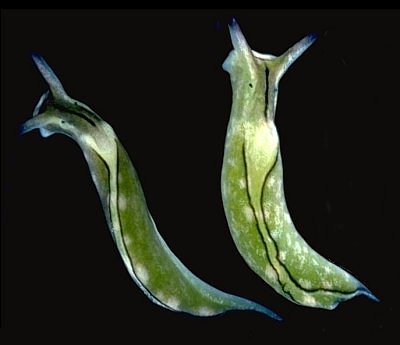
Elysia australis
(Quoy & Gaimard, 1832)
Order: SACOGLOSSA
Superfamily: ELYSIOIDEA
Family: Elysiidae
DISTRIBUTION
Throughout Australia
PHOTO
UPPER RIGHT: Coffs Harbour Region, northern New South Wales, December 1990.
LOWER LEFT: Dark 7mm long juvenile, Newport, Sydney, NSW, July 1996.
LOWER RIGHT: enlarged section showing branching of the digestive gland with clusters of chloroplasts obtained from its algal food. Eyre Peninsula, South Australia, February, 1985. PHOTOS: Bill Rudman.
Common intertidal elysiid throughout southern Australia, and recent records from Darwin suggest it occurs all around the Australian continent. Ranges in colour from a light to very dark green with various degrees of black dusting over parts of the body. The parapodia are usually edged in black and the tip of the 'tail' and rhinophores are black. The most distinctive colour feature is the black T-shape on the head consisting of a median line between the rhinophores, and a transverse line across in front of them. Sometimes the transverse line is absent. It grows to about 25mm but 10-15mm long animals are most common on intertidal rock platforms.
See References to biology, natural history and geographic distribution.
References:
• Quoy, J.R. & Gaimard, J.P. (1832). Voyage de decouvertes de L'Astrolabe pendant les annees 1826-1827-1828-1829, sous le commandement de M.J. Dumont D'Urville, Zoologie, 2: 1-686.
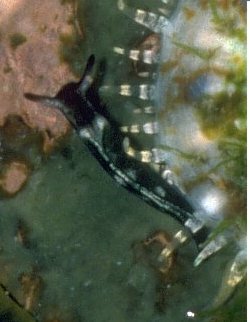
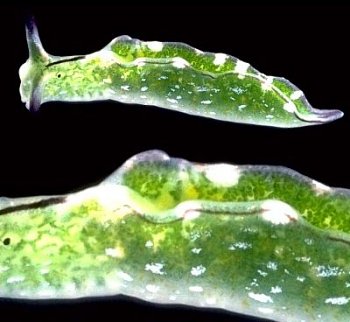
Rudman, W.B., 2000 (September 9) Elysia australis (Quoy & Gaimard, 1832). [In] Sea Slug Forum. Australian Museum, Sydney. Available from http://www.seaslugforum.net/find/elysaust
Related messages
Elysia australis from Wollongong, south-eastern Australia
September 15, 2005
From: Sascha Schulz
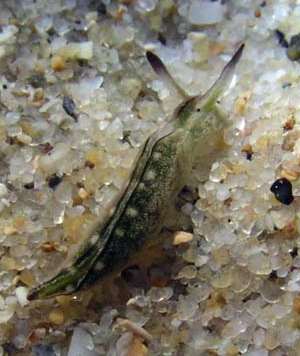
Dear Bill,
Is this Elysia australis ?
Locality: Wollongong, NSW, Australia. rockpool. Approx 12 mm long. May 2005
Sascha Schulz
ss31@dodo.com.au
Schulz, S., 2005 (Sep 15) Elysia australis from Wollongong, south-eastern Australia. [Message in] Sea Slug Forum. Australian Museum, Sydney. Available from http://www.seaslugforum.net/find/14758Dear Sascha,
Yes this is Elysia australis, It is often very common in intertidal rockpools and rock platforms
Best wishes,
Bill Rudman
Information on Elysia australis
September 11, 2000
From: Clare Norton
I was wondering if you had a photo of Elysia australis? Also, I have heard that this species is found in rockpools around Sydney and Wollongong. If this is correct, I was wondering if you knew of any localities where they are likely to be found? I am interested because I have to do a project for uni about developing an experiment to sample E. australis. I don't actually have to conduct the experiment but I have searched for them without success and it would greatly help me to design an experiment if I could actually observe some in the field.
Thanks for your time and help,
Clare Norton
cnor2499@mail.usyd.edu.au
Norton, C., 2000 (Sep 11) Information on Elysia australis. [Message in] Sea Slug Forum. Australian Museum, Sydney. Available from http://www.seaslugforum.net/find/2977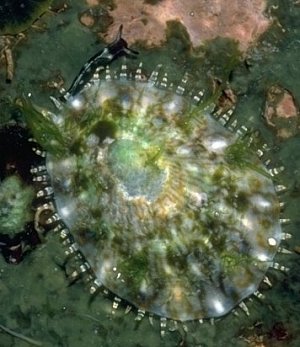
Dear Clare,
I've prepared a page with some photos showing the colour range of this often common little Elysia. It is certainly common at times around Sydney and Wollongong [central New South Wales]. The best place to look is on intertidal rock platforms in places which stay wet at low tide. Not so much deep pools but shallow depressions which retain a centimeter or so of water. One good place, but there are many others like it, is Newport in northern Sydney, where most of the rock platform at low tide consists of shallow depressions in which small algal plants thrive.
Like many sacoglossans, E. australis is not that easy to see because much of its colour comes from the chloroplasts of the algae it has recently eaten. I have included a photo alongside of a juvenile (3-4mm long) from Newport keeping the company of a juvenile limpet Cellana tramoserica. I guess the easiest (or only) way to find them is to find a likely spot and just sit and watch for signs of activity. Compared with other inhabitants, little Elysia crawling along, look quite busy. - and how many other people could sit at the beach on a nice sunny day contemplating a rockpool and say they were working?
Good luck with your search,
Best wishes,
Bill Rudman.
